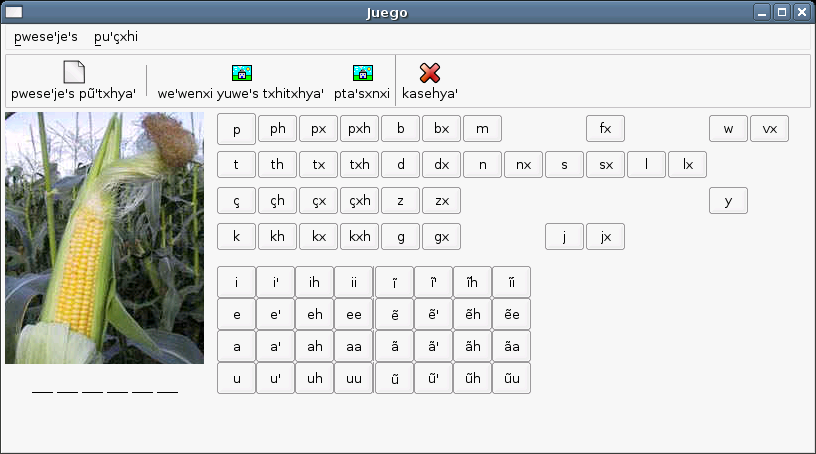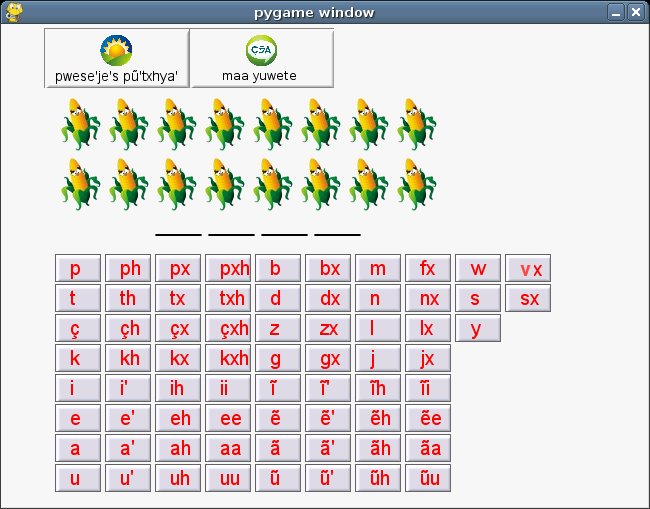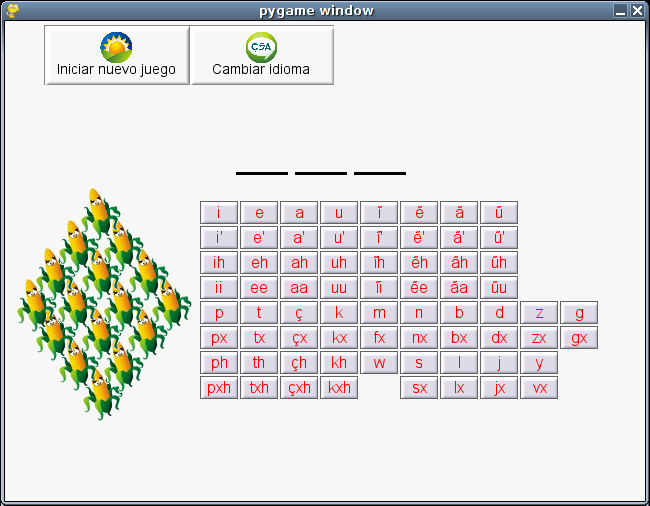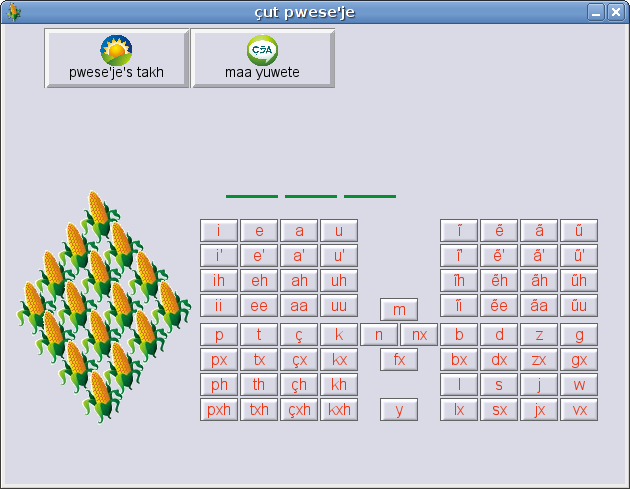Çut pwese'je
To test some guidelines for developing suitable software for the Nasa people, we decided to develop a Nasa Yuwe Word-guessing game, a kind of "hangman", not with man that finally dead hanged up, but with a maize plant that lost all its lefts and grains if the user fails to find the word. It was called çut pwese'je (the maize game).
Nasa Yuwe has 69 linguistic units, represented by one, two or three letters from the Latin alphabet, e.g: i, px, çh, txh. The game should display a Nasa Yuwe keyboard with a button for each one of the linguistic units. That will help Nasa children to identify that they represent different sounds.
The more important aspects of the prototype evolution design is described here in a very summarized way.
First prototype
Non-functional model, just a gtk interface made with glade to look for a initial direction.
Features/To be changed:
- We found that a Nasa Yuwe-speaker would need around 16 chances to guess a word, with a medium level, not so easy, not so hard. Representing the changes in a single maize could not be very visible, so, we decided to have 16 plants, in the way that a plant disappears with each incorrect guess.
- The keyboard "layout" was based on a linguistic model. The black spaces between buttons didn't have any sense in the game, so they must be removed.
Second prototype
This was a functional version, implemented in pygame and tested by 4 Nasa children.
Features/To be changed:
- Using 16 humanized maize plants ranged in two rows.
- Testing a new game icon, between the used in glade for the New function, and a rising sun in a mountain landscape. The girls expressed that they only go out to play when the sun is shining, so, the latter icon was preferred.
- The keyboard distribution was heaped, it was not easy to found some letters. A new one was needed.
- The keyboard was too large in relation with the other interface elements. They didn't give the children the idea of game.
Third prototype
Between 2nd and 3rd versions, we found an important Nasa element: the ũhza yafx, a rhombus-based shape recognized by Nasa people as part of their World-view. There are not written references about it, but a little description was learned by oral-way. Summarizing: the four more important Nasa gods are in the corners; ũhza yafx has two division, resulting the upper and lower worlds; all the elements are just one unit, which is the Nasa nation origin.
A numerical sequence emerges from ũhza yafx: 4-2-4-1-4... This sequence is used in the Nasa Yuwe teaching, where children first learn p, t, ç, k, followed by m and n, followed by b, d, z, g, and so on. We wanted to take profit of it in the game. In this model, a dozen keyboard layouts were evaluated, they were designed trying to take into account the numerical sequence and the importance of number 4.
Another point was that a rhombus is easily made with 16 elements, so the maize plants perfectly fitted in that kind of shape.
Testing the model, we found that Nasa people didn't like the humanized maize pictures, so that would be changed in the next version.
Fourth prototype
This model was tested by around 30 Nasa people.
The ũhza yafx was identified, the keyboard distribution was more clear, the keys were founded more easily. The Nasa users liked this version, and for sure, it was more Nasa than the previous ones.
A question before testing it, was the disappearance order when the player chooses a wrong key. As the 4 more important gods are found in the corners, we decided to left that for the end, starting from the center. The reaction from the Nasa tester was: "only a dog eats at center at the begging, a good Nasa starts from the borders and ends in the center". So, the order was finally changed, it describes a swirl, another Nasa important element, it represent the life developing way. (This makes me think about the icons appearing sequence in the Sugar donnut).
I think that the development was successful, cultural aspect were included in the game interface and it was accepted by the Nasa community.



